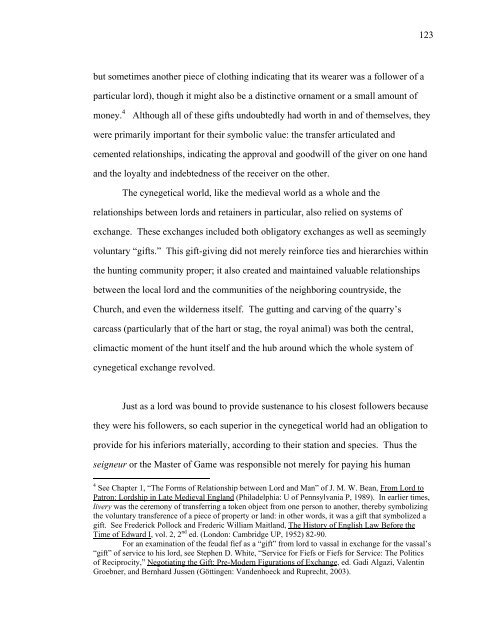Chapter 4 The Gift.pdf - eCommons@Cornell
Chapter 4 The Gift.pdf - eCommons@Cornell
Chapter 4 The Gift.pdf - eCommons@Cornell
Create successful ePaper yourself
Turn your PDF publications into a flip-book with our unique Google optimized e-Paper software.
ut sometimes another piece of clothing indicating that its wearer was a follower of a<br />
particular lord), though it might also be a distinctive ornament or a small amount of<br />
money. 4 Although all of these gifts undoubtedly had worth in and of themselves, they<br />
were primarily important for their symbolic value: the transfer articulated and<br />
cemented relationships, indicating the approval and goodwill of the giver on one hand<br />
and the loyalty and indebtedness of the receiver on the other.<br />
<strong>The</strong> cynegetical world, like the medieval world as a whole and the<br />
relationships between lords and retainers in particular, also relied on systems of<br />
exchange. <strong>The</strong>se exchanges included both obligatory exchanges as well as seemingly<br />
voluntary “gifts.” This gift-giving did not merely reinforce ties and hierarchies within<br />
the hunting community proper; it also created and maintained valuable relationships<br />
between the local lord and the communities of the neighboring countryside, the<br />
Church, and even the wilderness itself. <strong>The</strong> gutting and carving of the quarry’s<br />
carcass (particularly that of the hart or stag, the royal animal) was both the central,<br />
climactic moment of the hunt itself and the hub around which the whole system of<br />
cynegetical exchange revolved.<br />
Just as a lord was bound to provide sustenance to his closest followers because<br />
they were his followers, so each superior in the cynegetical world had an obligation to<br />
provide for his inferiors materially, according to their station and species. Thus the<br />
seigneur or the Master of Game was responsible not merely for paying his human<br />
4 See <strong>Chapter</strong> 1, “<strong>The</strong> Forms of Relationship between Lord and Man” of J. M. W. Bean, From Lord to<br />
Patron: Lordship in Late Medieval England (Philadelphia: U of Pennsylvania P, 1989). In earlier times,<br />
livery was the ceremony of transferring a token object from one person to another, thereby symbolizing<br />
the voluntary transference of a piece of property or land: in other words, it was a gift that symbolized a<br />
gift. See Frederick Pollock and Frederic William Maitland, <strong>The</strong> History of English Law Before the<br />
Time of Edward I, vol. 2, 2 nd ed. (London: Cambridge UP, 1952) 82-90.<br />
For an examination of the feudal fief as a “gift” from lord to vassal in exchange for the vassal’s<br />
“gift” of service to his lord, see Stephen D. White, “Service for Fiefs or Fiefs for Service: <strong>The</strong> Politics<br />
of Reciprocity,” Negotiating the <strong>Gift</strong>: Pre-Modern Figurations of Exchange, ed. Gadi Algazi, Valentin<br />
Groebner, and Bernhard Jussen (Göttingen: Vandenhoeck and Ruprecht, 2003).<br />
123

















